Women's Hair Loss Causes
Overview
Baldness in women which is also known as female pattern alopecia is genetically inherited either from the maternal side or the paternal one. Female alopecia occurs mostly in a diffused pattern, causing hair loss over the entire region of the scalp. Women usually don’t face a patterned distribution of hair loss in which thinning of hairs occurs both on the frontal and top region of the scalp with lesser hair loss occurring on the sides and rear of the scalp.
Whatever type of hair loss women face, whether it’s diffuse or patterned, there are different treatments for both conditions. Women who face diffuse hair loss can be best treated medically, while women who face patterned hair loss can opt for a hair transplantation procedure.
Genes
Pretty much like men female genetic hair loss is concerned with genes, hormones and age. But understanding genetics that causes hair loss is even tougher in women. Apart from possessing 5-a reductase, testosterone, and dihydrotestosterone(DHT), women also possess the enzyme aromatase and female hormones estrone and estradiol which are also responsible for causing hair loss in women.
Like men, women also possess 5-a reductase enzyme which reacts with testosterone to produce DHT, which leads to the miniaturization of hair amongst them. But the reason they don’t go completely bald is primarily because they possess 5-a reductase only in half quantity as compared to men. Furthermore, the enzyme aromatase present in women known to form the female hormones, estrone and estradiol, subsides the effect of DHT. They possess much more aromatase than men along the frontal hairline due to which do not lose hair extensively in that region. It also explains the reason why women don’t benefit much from finasteride (Propecia), which is primarily known to block the formation of DHT amongst men.
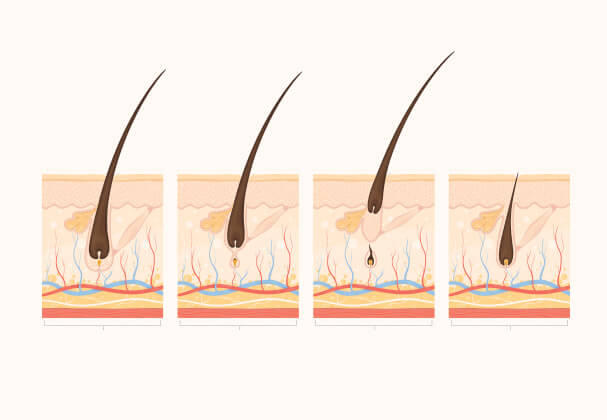
Medical Conditions Leading to Diffuse Hair Loss in Women
-
1
Conditions related to child birth and gynecology.
-
3
Thyroid disease
-
5
Conditions related to nutrition which can include unhealthy diets, bulimia, protein/calorie deficiency, etc.
-
2
Anemia (iron deficiency)
-
4
Connective tissue diseases
-
6
Stress that occurs due to surgical procedures that are conducted or anesthesia
Medical Conditions Leading to Diffuse Hair Loss in Women
-
1
Conditions related to child birth and gynecology.
-
2
Anemia (iron deficiency)
-
3
Thyroid disease
-
4
Connective tissue diseases
-
5
Conditions related to nutrition which can include unhealthy diets, bulimia, protein/calorie deficiency, etc.
-
6
Stress that occurs due to surgical procedures that are conducted or anesthesia
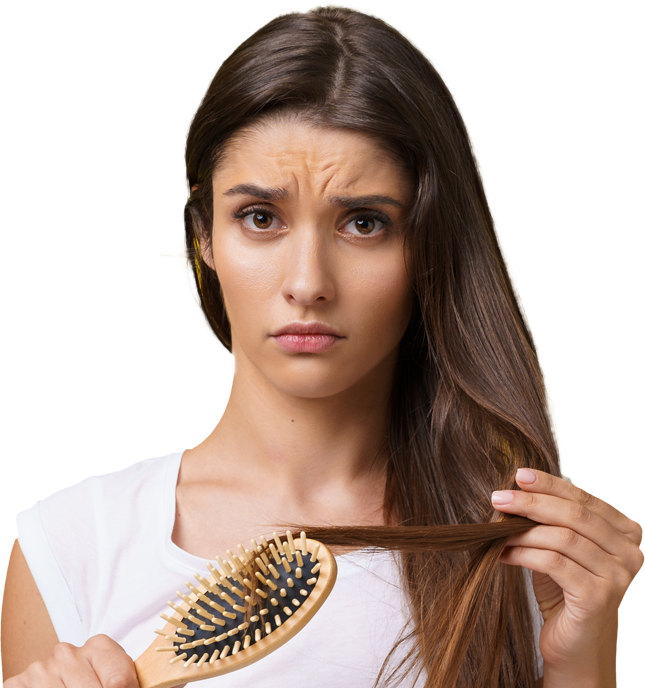
Women's Hair Loss Classification
Not much hair loss occurs in this stage. The hair is usually thin in this stage which can be easily hidden with proper grooming.

Though many doctors believe that ‘hair loss is primarily inherited from the mother’s side of the family’ yet the truth is that hair loss may be acquired from either of the parents. According to various studies conducted on the x-chromosome which is known to influence hair loss, it’s been concluded that inheriting hair loss is slightly higher from the maternal side as compared to the paternal side.
It’s been found that understanding genetics in male pattern baldness is more difficult than previously thought.
Recent discovery of androgen receptor gene (AR) which is found in the x-chromosome provides ample reasons as to why the hair loss pattern of a man is pretty similar to his maternal grandfather than his own father. But inheritance of hair loss is not only limited to the maternal side, there also have been cases in which men have inherited baldness from their paternal side. But there’s no clear evidence as to how this type of transmission must have occurred.
A gene is basically a single element of a chemically encoded hereditary instruction which is located on the chromosome and which comprises a small bit of the DNA. There are 23 pairs of chromosomes found in humans and every individual acquires one pair of chromosomes from each parent. It’s been found that hair loss in men is not the result of a single gene.
Primarily genes that are present within the X or Y-chromosomes are referred to as sex-linked chromosomes. The others present on the other 22 are autosomal in nature. Hair loss in men is not only the result of a sex-related genes but also autosomal genes (non sex-related). What this basically infers is that baldness may be acquired from either of the parents but not with some definite frequency.
Though many genes that are responsible for male pattern baldness have been mapped and identified yet still a lot needs to be discovered for limiting hair baldness in men.
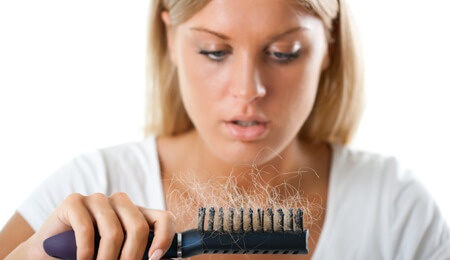
There are many dermatologic conditions that are known to cause localized hair loss amongst women. It can be diagnosed by an experienced dermatologist by conducting a scalp biopsy. It can be of two types: Scarring and Non Scarring.
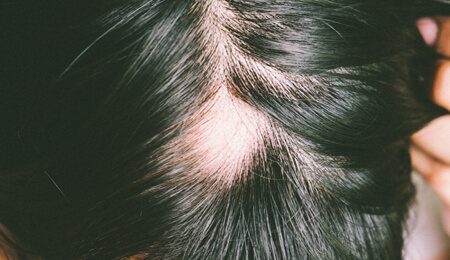 It may be caused due to Discoid Lupus, Lichen Planus, thermal burns, local radiation therapy, face-lift surgeries and other infections. These alopecias can be treated effectively with hair transplantation.
It may be caused due to Discoid Lupus, Lichen Planus, thermal burns, local radiation therapy, face-lift surgeries and other infections. These alopecias can be treated effectively with hair transplantation.
 Alopecia Areata is a genetic disease in which an individual abruptly faces round patches of hair loss though the skin underneath seems perfectly fine.
Alopecia Areata is a genetic disease in which an individual abruptly faces round patches of hair loss though the skin underneath seems perfectly fine.
Localized hair loss may also occur due to constant pulling of hairs which may be caused due to braiding or tight clips. It may lead to their (hair) thinning in the process. It’s possible to reverse the situation if the hairs are let loose. It’s essential that the tugging impact gets reduced so that the hair can recover from injury.
 Though there are other dominant factors which may cause hair loss, yet aging also plays a significant role in decreasing the volume of hair on an individual’s scalp. Senile alopecia is described as that condition in which an individual gradually loses hair and their thickness due to aging and is in no way connected to genetic balding. So, it’s definite that individuals will lose hair gradually due to aging but there’s really no certainty at what point this process may begin in an individual’s life since everybody’s genetic makeup varies radically.
Though there are other dominant factors which may cause hair loss, yet aging also plays a significant role in decreasing the volume of hair on an individual’s scalp. Senile alopecia is described as that condition in which an individual gradually loses hair and their thickness due to aging and is in no way connected to genetic balding. So, it’s definite that individuals will lose hair gradually due to aging but there’s really no certainty at what point this process may begin in an individual’s life since everybody’s genetic makeup varies radically.

Type 1 (mild stage)
Not much hair loss occurs in this stage. The hair usually thin in this stage which can be easily hidden with proper grooming.

Type 2 (moderate stage)
More hairs become thin and are lost along the midline area in this stage. The area of hair loss occurrence widens and hair transplantation is a viable idea for this stage if the hairs are still stable in the rear and side areas of the scalp.
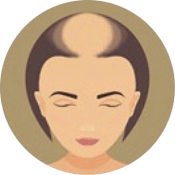
Type 3 (extensive stage)
In this stage, the hair is thin to such an extent that the middle part of the scalp goes almost bald. It leads to thinning of hair in nearby areas as well.
A unique feature that can be observed during Ludwig stages is that hair loss primarily occurs on the frontal and top part of the individual’s scalp and much of the frontal hairline is preserved. The rear and side areas are barely affected. Therefore, women who experience hair loss must get it properly diagnosed and acquire proper medication or treatment for the same before the situation becomes critical and extreme.
Women's Hair Loss Diagnosis
The tests conducted to diagnose hair loss in women can be simple or complicated:
- Gently pulling on your hair to see how many hairs come out.
- Blood tests. These assessments are for vitamin and mineral levels (like vitamin D, vitamin B, zinc and iron) and hormone levels (incorporating thyroid and sex hormones).
- Scalp analysis under a microscope and trichoscopy.
- Scalp biopsy to extract and analyse a very small piece of scalp skin.
Treatments
- In circumstances where the loss is due to stress or hormone shifts like pregnancy, there might be no treatment required. The hair loss will stop after some time.
- In cases of hair loss due to hair styling techniques, like tight braids or ponytails or specific chemicals, treatment means not doing the things that caused the damage.
- In cases due to nutritional deficits, you might be told to take supplements. For example, you might be told to take a multivitamin and 3 to 5 milligrams of biotin daily. Minoxidil (Rogaine®) is approved for treating FPHL.
- Hair transplant surgery is another option. Small parts of the scalp with hair follicles are brought from the back of the head and pushed to slits in the regions of baldness. Potential issues with this treatment contain the normal risks of surgery like infection, folliculitis and shock loss — where the hair falls out in the transplant area. In cases where the bald spots are large, there might be trouble trying to find sufficient hair to transplant. You can visit our doctors at MedLinks and find the best possible treatment for you!
Frequently Asked Questions
It is usual to lose about 100 – 150 hair strands each day.
Both men and women can experience androgenetic alopecia, which is triggered by hormones and genetics. Hair loss often happens quickly and more broadly in men. Hair loss in men may personify as early as adolescence with the onset of hair recession near the temples, and the formation of the characteristic “M” shaped hairline. Hair loss in women, on the other hand, ventures diffuse thinning at the top of the head, which shows at the part line. Diffuse thinning can happen as early as their 20s and 30s, due to hormonal changes and aging. In some circumstances, hair thinning and baldness in women may also be caused by treatable illnesses such as thyroid disease or anemia.
This depends on the amount of stress you are experiencing and how much impact it has on the general functions of your body. Normally, the gentle stress we experience on a day-to-day basis does not cause hair loss. However, severe stress that is a result of severe or traumatic events, such as divorce, a drastic change in diet, surgery, or severe weight loss, may cause a physiological imbalance in your system.
Yes, it works! The transplanted hair is removed from the back of the scalp (donor site) and moved to the bald site (recipient site).
The transferred tissue is not “rejected” as it is not foreign tissue. The transplanted hair retains its characteristics; texture, colour, growth rate, and curl, after transplantation and re-growth.
Most patients see results between 6 and 9 months after surgery. For some patients, it takes 12 months.
It’s essential to know that between 2 and 8 weeks after the surgery, the transplanted hair will fall out. This is usual. By the third month, the hair may look thinner than before you had the transplant. Again, this is normal.
- Don’t sleep or lie on your face as it might cause swelling. Sleep with your head elevated to 30 degrees, at least for 3 days.
- Don’t consume alcohol or alcoholic beverages for at least 3 days after the surgery.
- Avoid visiting dirty or dusty environments for at least a week after the procedure.
- Shampoo very gently for the first week after the procedure. Since grafts are permanent, one can resume normal hair care and shampoo after 10 days.
- Restrain yourself from smoking for at least 2 weeks after the surgery.
- Avoid consuming any kind of medications that affect blood flow.
- Don’t have a haircut for at least 3 weeks after the surgery.
- Don’t colour or dye your hair for at least 4 weeks after the surgery.
Looking for guidance?
Book a consultation today and clear all your doubts with MedLinks!

Looking for guidance?
Book a consultation today and clear all your doubts with MedLinks!

